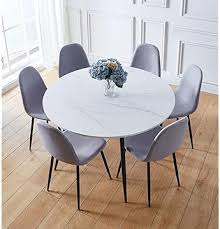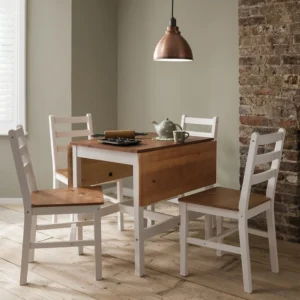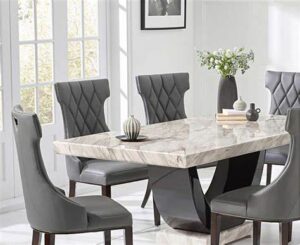Dining Room Tables :
Dining tables and chairs play a pivotal role in shaping the ambiance of a dining space, reflecting both functionality and style. Understanding the history, diverse styles, shapes, materials, and essential do’s and don’ts can empower you to make informed decisions when selecting the perfect dining set for your home.
A Brief History:
Dining tables and chairs have evolved significantly throughout history, reflecting societal changes and design trends. In ancient times, dining was often a communal experience around a simple table. As social structures evolved, so did the design of dining furniture. In the Renaissance, intricately carved wooden tables became popular, symbolizing wealth and status. The Victorian era introduced formal dining, and the 20th century saw a surge in modern, minimalist designs.
Styles and Types of Dining Room Tables:
The terms “style” and “type” are often used interchangeably when discussing furniture, but they actually refer to different aspects:
Style: Style refers to the aesthetic or design elements of the furniture, including its overall look, decorative details, and artistic characteristics. It encompasses factors such as the shape, material, colour, finish, and decorative elements of the dining table and chairs. Examples of dining table and chair styles include modern, traditional, rustic, industrial, Scandinavian, farmhouse, mid-century modern, and Victorian, among others.
Type: Type refers to the functional or structural characteristics of the furniture, including its size, shape, and intended use. It may also refer to specific design features or construction methods. For dining tables and chairs, types can vary based on factors such as size (e.g., round, rectangular, square), shape (e.g., pedestal, trestle, extension), material (e.g., wood, glass, metal), and seating capacity. Examples of dining table types include formal dining tables, casual dining tables, breakfast nooks, bar-height tables, and outdoor dining tables.
To summaries while style focuses on the aesthetic or design elements of furniture, type pertains to its functional or structural characteristics. When choosing dining tables and chairs, it’s essential to consider both the style and type to ensure they meet both your aesthetic preferences and functional needs.:
Styles of Dining Tables:

Traditional: These tables typically feature classic designs with ornate detailing, often made from wood such as oak or mahogany. They may include intricate carving and turned legs, providing a timeless and elegant look.

Modern: Modern dining tables often embrace sleek lines, minimalist designs, and innovative materials such as glass, metal, or acrylic. They prioritize functionality and simplicity, making them suitable for contemporary interiors.

Farmhouse: Farmhouse dining tables exude rustic charm with their sturdy construction and often feature distressed finishes. They commonly incorporate elements like thick wooden tops, turned legs, and a distressed or weathered appearance, reminiscent of country-style living.

Industrial: Inspired by factory and warehouse aesthetics, industrial dining tables typically incorporate elements like raw metal frames, reclaimed wood tops, and minimalist designs. These tables often showcase a blend of ruggedness and simplicity, perfect for urban or loft-style spaces.

Scandinavian: Scandinavian dining tables are characterized by clean lines, natural materials, and light finishes. They often feature tapered legs, smooth surfaces, and a focus on functionality, reflecting the principles of Scandinavian design which prioritize simplicity, utility, and natural beauty.

Mid-Century Modern: Reflecting the design ethos of the mid-20th century, these dining tables typically feature sleek, geometric shapes, tapered legs, and organic forms. They often incorporate materials like teak, walnut, or plywood, showcasing a balance between form and function.

Coastal: Coastal dining tables evoke a sense of seaside living with their light and breezy designs. They often feature whitewashed or light-toned wood, rattan or wicker accents, and simple, relaxed lines, creating a casual and inviting atmosphere.

Baroque: Baroque dining tables are characterized by opulence and grandeur, featuring intricate carving, gilding, and luxurious materials such as marble or elaborately veneered wood. These tables often serve as focal points in formal dining rooms, exuding a sense of extravagance and sophistication.

Art Deco: Art Deco dining tables showcase geometric shapes, luxurious materials, and bold designs inspired by the Roaring Twenties. They may feature mirrored surfaces, sleek lines, and exotic woods, embodying a sense of glamour and sophistication.

Rustic: Rustic dining tables celebrate the natural beauty of wood with their rough-hewn surfaces, knots, and imperfections. They often feature chunky legs, plank-style tops, and a distressed or reclaimed finish, imparting a cosy and inviting feel reminiscent of countryside living.
Types of Dining Room Tables:

Rectangular Dining Table: A classic choice suitable for most dining spaces, providing ample surface area and accommodating multiple chairs along its length.

Round Dining Table: Encourages conversation and intimacy due to its shape, ideal for smaller dining rooms or cosy gatherings.

Square Dining Table: Offers a modern and symmetrical look, often seating four people comfortably, fitting well in square-shaped rooms or as a breakfast nook table.

Oval Dining Table: Combines the advantages of both round and rectangular tables, offering a more fluid shape while still providing ample seating space.

Extension Dining Table: Features additional leaves that can be inserted to extend the table length, providing flexibility for accommodating larger gatherings.

Drop-leaf Dining Table: Versatile and space-saving, with hinged leaves that can be folded down when not in use, making it suitable for smaller dining areas.

Trestle Dining Table: Characterized by a sturdy support structure with two or more upright pieces connected by a horizontal beam (trestle), providing stability and legroom.

Pedestal Dining Table: Supported by a single central column or pedestal instead of traditional legs, offering flexibility in seating arrangements and maximizing legroom.

Glass-Top Dining Table: Modern and elegant, featuring a sleek glass surface supported by various materials such as metal or wood, creating an illusion of space and light.

Marble-Top Dining Table: Exudes luxury and sophistication with its elegant marble surface, often featuring intricate veining and natural variations, suitable for formal dining areas.
The Materials tables can be made from:
Wood: A timeless and versatile option, wooden dining tables come in various finishes and styles. Hardwoods like oak and walnut are durable, while lighter woods like pine offer a more casual feel.
Glass: Glass tables contribute to an airy and open ambiance, making them an excellent choice for smaller spaces. Tempered glass is durable and safe, ensuring longevity.
Metal: Industrial and modern dining tables often incorporate metal elements, providing a sleek and contemporary look. Stainless steel and iron are popular choices for durability and aesthetic appeal.
The Do’s and Don’ts When Buying:
Do:
Measure your space: Ensure the dining table fits comfortably within your dining area, leaving enough room for chairs and movement.
Consider your lifestyle: Choose materials and styles that align with your daily activities and family needs.
Test the comfort: Sit in the chairs and visualize the dining experience. Comfort is key for prolonged enjoyment.
Weight: Make sure you know how much weight a chair can safely hold.
Don’t:
Ignore maintenance: Consider the upkeep required for your chosen material. Some materials may require more care than others.
Overcrowd the space: Avoid selecting a table that overwhelms your dining area. Balance is crucial for a harmonious look.
Sacrifice quality for cost: Invest in a dining set that balances cost with quality. Durability and craftsmanship ensure a long-lasting investment.
Dining tables and chairs are more than mere furniture; they are essential elements that contribute to the heart and soul of your home. By understanding the history, styles, shapes, and materials available, you can make informed decisions to elevate your dining space, creating a haven for memorable meals and cherished moments.




